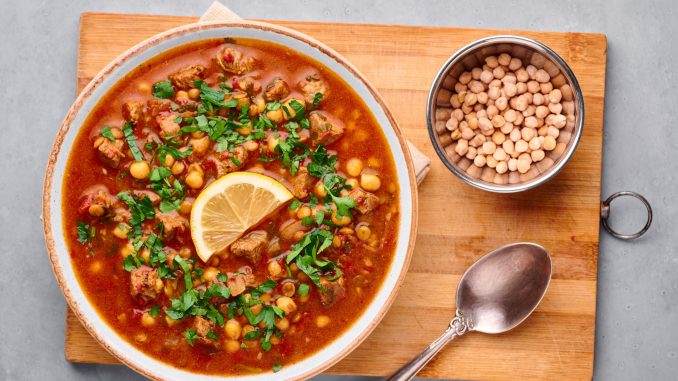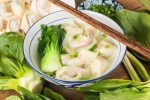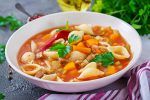
Moroccan Harira soup is regularly consumed for breakfast during and even after Ramadan. It also seems ideal as a January dish when the weather is grey and dull and sustenance of the highest order is desired. It is a simple rich dish prepared with lentils Taking inspiration from Sophie Grigson’s version in ‘The Soup Book’, I asked some of my friends in the restaurant trade how they would prepare this dish. Good quality lamb is what is needed! Chicken is what you need! It is versatile enough to accommodate, successfully, all types of meat. Nonetheless, lentils offer great versatility and with all those other heart-warming ingredients a whole meal too and in a form which is easy to digest.
Talking of chefs, Jamie Oliver presented a version in his magazine from January 2016 which is where I first encountered it. Strange how January seems to welcome this type of food.
The Essence of Harira
Moroccan Harira is a hearty soup that’s more than just a culinary creation; it’s a symbol of Moroccan identity and tradition. This wholesome dish is often associated with the holy month of Ramadan as we mentioned earlier, when it plays a central role in breaking the daily fast. Its origins are deeply rooted in the blending of Berber, Arab, and Moorish influences, resulting in a dish that reflects the diversity and rich history of Morocco.
At its core, harira is a tomato-based soup that incorporates legumes, protein (usually lamb or chicken), and a delightful medley of aromatic herbs and spices. While the essential ingredients remain constant, the exact preparation can vary from one family to another, making each bowl of harira a unique expression of culinary artistry.
Cultural Significance
Harira is more than just a dish; it’s a cultural symbol and a source of pride for Moroccans. Its role in the holy month of Ramadan is particularly noteworthy. During this period, the preparation and consumption of harira signify not only nourishment for the body but also spiritual and communal nourishment. Families gather together to break their fast with a bowl of harira, following a tradition that has been passed down through generations.
Beyond Ramadan, harira is enjoyed at various celebrations, family gatherings, and everyday meals. It serves as a warm and welcoming gesture, embodying Moroccan hospitality and the strong ties that are formed over shared meals.
Ingredients and Flavor Profile of Moroccan Harira Soup
Harira’s unique flavor profile is a harmonious blend of ingredients and spices that create a symphony of tastes. Here are some of the key elements that contribute to harira’s distinctive flavor:
- Tomatoes: The base of harira is a tomato-rich broth, giving the soup its vibrant red color and a subtly tangy and sweet undertone.
- Legumes: Chickpeas and lentils are commonly used in harira, adding a hearty and satisfying element to the soup.
- Protein: Lamb or chicken is traditionally used to add depth and richness to the soup. The meat is often slow-cooked until tender, infusing the broth with a savory note.
- Aromatic Herbs: Fresh herbs like cilantro and parsley are essential to the dish, adding brightness and freshness. They are often stirred into the soup just before serving.
- Spices: Harira’s distinctive flavor comes from a combination of spices, such as ginger, cinnamon, coriander, and cumin. These spices impart a warm and earthy quality, with a hint of sweetness and spice.
- Lemon: A squeeze of fresh lemon juice is added at the end, brightening up the flavors and adding a touch of acidity.
- Egg and Flour: A common variation of harira involves adding a mixture of eggs and flour, which thickens the soup and adds a unique texture.
- Variations: Some versions of harira incorporate rice, vermicelli, or other grains for additional texture and substance.
Preparation and Tradition
The preparation of harira is not just about following a recipe; it’s a journey that showcases the art of Moroccan cooking. Making harira is a labor of love, often requiring patience and attention to detail. Families pass down their own cherished recipes, each with its own unique twist.
The process begins with sautéing aromatic ingredients like onions, garlic, and a medley of spices. The meat is browned, allowing its flavors to meld with the spices and create a robust base for the soup. Next, the tomatoes and legumes are added, followed by a slow simmer that allows all the elements to come together.
As harira simmers, the kitchen is filled with the tantalizing aroma of spices and herbs, drawing family members together in anticipation of the meal. Finally, just before serving, a generous handful of fresh herbs is stirred into the soup, infusing it with a burst of green and a touch of freshness.
Serving and Enjoyment
Harira is often served with dates and traditional Moroccan bread, like khobz. The combination of sweet dates, savory bread, and hearty soup creates a balanced and satisfying meal. The act of breaking bread and sharing harira fosters a sense of community and togetherness.
While harira is commonly enjoyed during Ramadan, it’s a dish for all seasons. Whether you’re celebrating a special occasion, sharing a meal with family, or simply seeking comfort on a chilly day, harira is a versatile and heartwarming choice.
Serves: 6 at least; Preparation time: 15 minutes; Cooking time: 1 hour 5 minutes.
Ingredients for Moroccan Harira Soup
- 2 -3 tbsp olive oil or rapeseed oil
- 1 large or 2 medium while/yellow onions, chopped roughly
- 1 carrot -chopped
- 1 large potato – chopped roughly including skin
- 500g shoulder or leg of lamb on the bone
- 1 tsp fresh minced ginger or ground ginger
- 1 small bunch parsley, finely chopped
- 1 small bunch coriander, finely chopped
- 1 tsp turmeric powder
- 1 tsp ground cinnamon
- 400g can chickpeas or 200g brown lentils, rinsed or a mix of both
- 400g can chopped tomatoes
- 2 tbsp tomato purée
- salt and freshly ground black pepper
- 100g vermicelli
- 30g plain flour
- lemon wedges, to serve
Preparation
- Heat the oil in a deep skillet, Dutch oven or soup pot over medium heat.
- Add the onion and carrots. Cook until the onions are tender and translucent but not brown.
- Cook the onion gently in the oil until tender and translucent. While it cooks, cut the meat from the lamb bones in 3cm (11⁄4in) cubes. Do not throw out the bones but leave them until added later.
- Once the onions are tender, stir in the spices, half the parsley, and half the coriander. Allow to simmer for 30 seconds.
- Add the meat and bones and turn to coat evenly. Add the lentils, tomatoes, and tomato purée and season. Mix well and simmer for a few minutes, then add 1.7 litres (3 pints) of water. Leave to simmer for 45 to 60 minutes.
- Remove the lamb bones and add the vermicelli and chickpeas.
- Add the potatoes, ginger, turmeric, broth, chicken, herbs, and tomato paste. Cook for 30 minutes.
- Season with lemon juice to taste.
- Serve with lemon wedges and crusty bread.


Leave a Reply